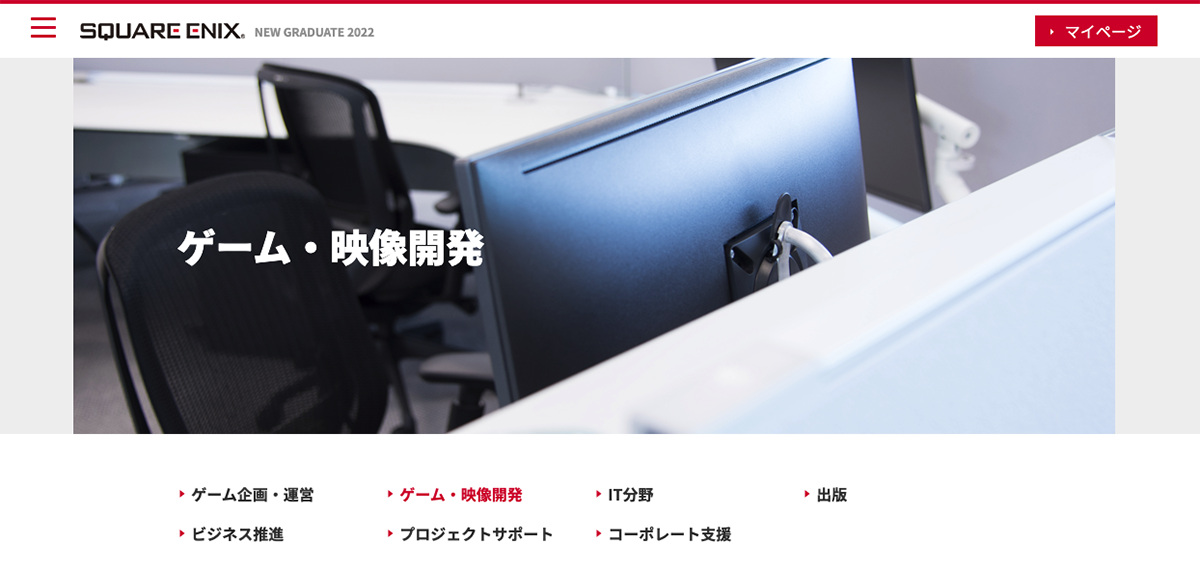【ポートフォリオ公開】スクウェア・エニックス社員に聞いた「会社所属のイラストレーター」のお仕事
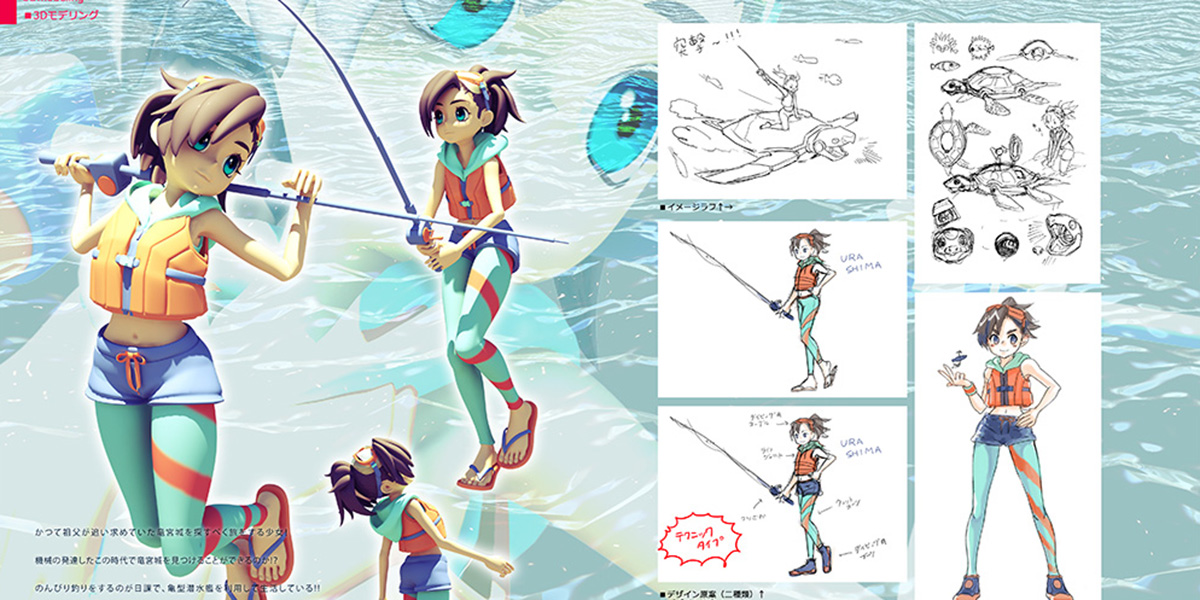
構成/直江あき
イラストレーターの働き方には、主に会社員とフリーランスがあります。
ですが、実際にイラスト業界に入らないとふたつの違いがわからず、どちらを選べばいいかわかりませんよね。
なので今回は、会社所属のイラストレーターとしてスクウェア・エニックスの社員の方にご登場いただきました。
現在放送中のアニメ『すばらしきこのせかい』のキャラクターデザインを担当されていて、採用側の経験もあるベテランの小林さんと、新卒で入社して5年目の下河邉さん。
おふたりに会社所属のイラストレーターの働き方やメリット、フリーランスとの違い、また会社所属になるために必要となってくる「ポートフォリオ」のこともなどをうかがっています。
ゲーム業界で絵を描く仕事に就きたい若者にとって必見の内容です。
キャラクターデザインという仕事
── おふたりのお仕事内容を教えてください。
下河邉:第一開発事業本部に所属しています。これまで、『聖剣伝説3 TRIALS of MANA』『DISSIDIA FINAL FANTASY NT』『KINGDOM HEARTS III』などに携わりました。これら作品では、キャラクターが持つ武器やエネミー(敵キャラ)のデザインをしています。
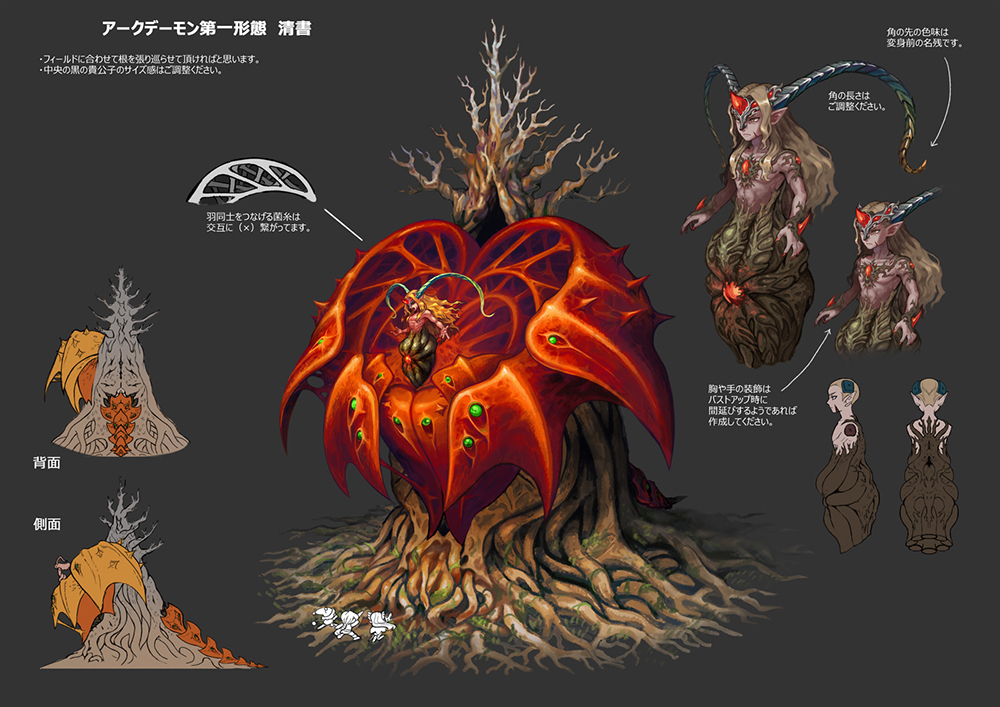
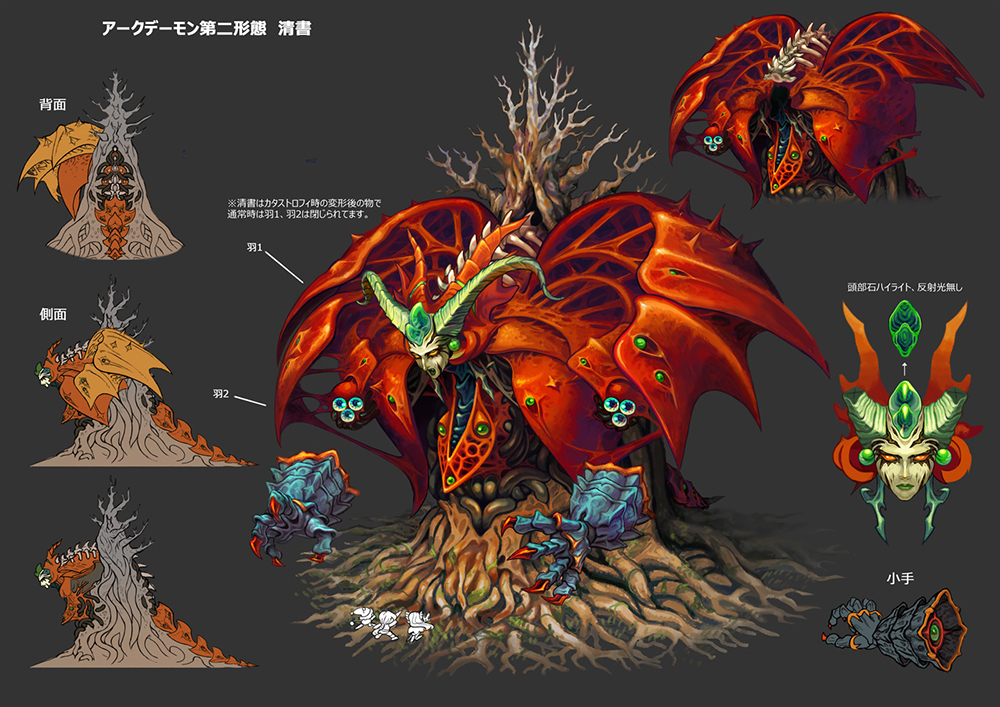
下河邉さんがデザインした『聖剣伝説3 TRIALS of MANA』のエネミー。デザインの詳細や意図が書き込まれています。
下河邉:最終的にゲームに載せるデータを「リソース」といいますが、そこまで仕上がるまでの工程の管理や、デザインの意図通りに表現できているかどうかのモーションの確認、監修も行っています。
3Dタイトルであれば、2Dでデザインを行い、その後モデラーさんが3Dにモデリングし、モーションをつけるといった工程もあります。
── 1体のキャラクターを作るのに、どれぐらいの時間がかかるものなんですか?
小林:ただキャラクターを2Dでデザインして終わりではなく、そのデザインをゲームに出して問題がないかというクオリティーの確認も必要です。そういうところを社内の責任者や、他社さんとの共同開発のケースではそちらの担当者さんに確認してもらうという工程を含めると、それぐらいになります。
下河邉:監修を待っている間は、別のエネミーをデザインしています。何体も同時進行している形ですね。
── ゲームの世界観を掴むのは大変そうですね。
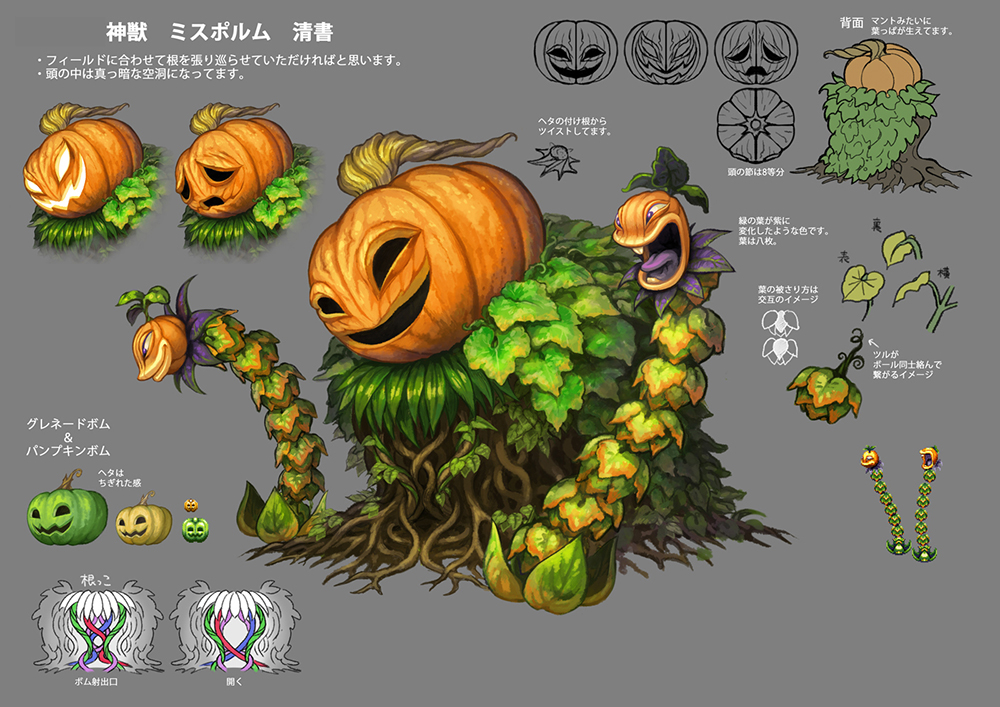
── ゲームはチームで作るものだと思いますが、ご自身の裁量はどれくらいあるのでしょうか。
小林:プロジェクトによって大きく変わるところです。「魚をモチーフに」といった企画側の要望がある場合も多いです。
── 思い入れのあるデザインはありますか?
下河邉:試行錯誤したのは、ゲームの仕様のギリギリを攻めたキャラクターをデザインしたときです。
そのデザインは周年イベントのお祝い系でとにかく賑やかに派手にする必要がありましたが、データや表現を盛り込みすぎると重くて動かないなどの制限がありました。モーションや実装の担当者と仕様を確認しつつ時間をかけてデザインを作りこみました。
キャラクターは、まず1枚絵として美しくなるようデザインしますが、最終的には動きが出ることを想定してデータを作る必要があります。特にボス戦に出てくるような大きなキャラクターは、頭や腕や武器といったパーツごとにデータが細かく分かれています。それらは色んな角度で動いたり、回転したりするんです。そのレイヤー構造や順序なども全て考える必要があります。
── レイヤー構造とはどういうものでしょうか?
デッサンから始まるポートフォリオ
── 下河邉さんの就職活動のときのポートフォリオを見せていただきます。採用の経験もある小林さんに、ポートフォリオを作る上でのポイントもあわせてお伺いできれればと思います。
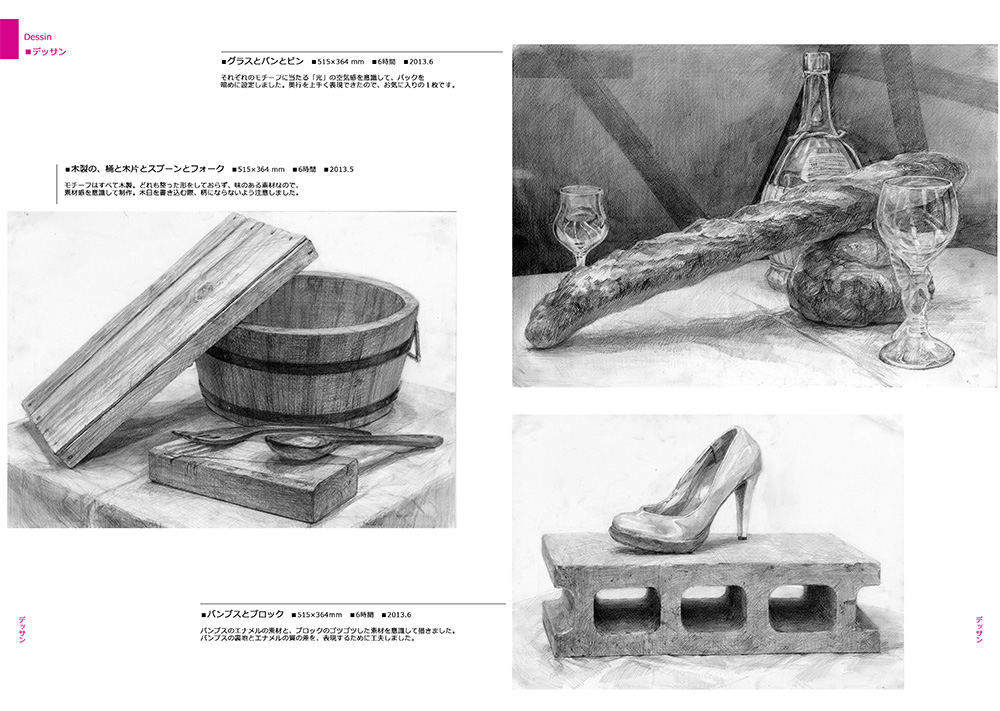
下河邉:ポートフォリオを作ったときも、「デッサンを一番最初に持ってくるのは珍しい」と言われました。でもデッサンを見ると画力が分かるかな、と。「私は良くも悪くもこれぐらい描けます!」というのを赤裸々に示して、基礎的な技量を見てもらいたかったんです。
その次はキャラクターの3Dモデリングです。
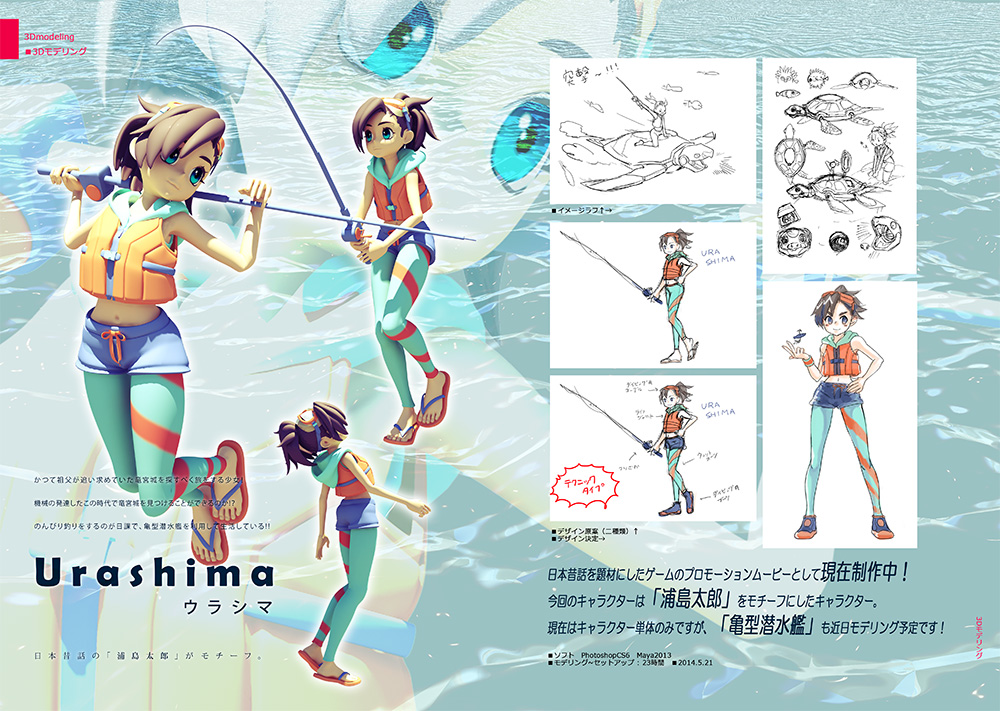
下河邉:当時はモデリングをするのが楽しく、力を入れていました。既存のゲームのキャラを3Dに起こしたものも実験作品として少し入れていますが、ほとんど自分で考えたオリジナルキャラです。
絵を立体的に見て破綻のないデザインができることや、絵をデータ的に捉えて制作できることをアピールしたくて配置しました。
小林:ポートフォリオのメインがイラストだとしても、3Dも混ぜてもらった方が、「勉強の意欲があるんだな」とか「色々模索しているんだな」と参考になります。もし3Dのデザインもできるのであれば、ぜひ入れてほしいですね。
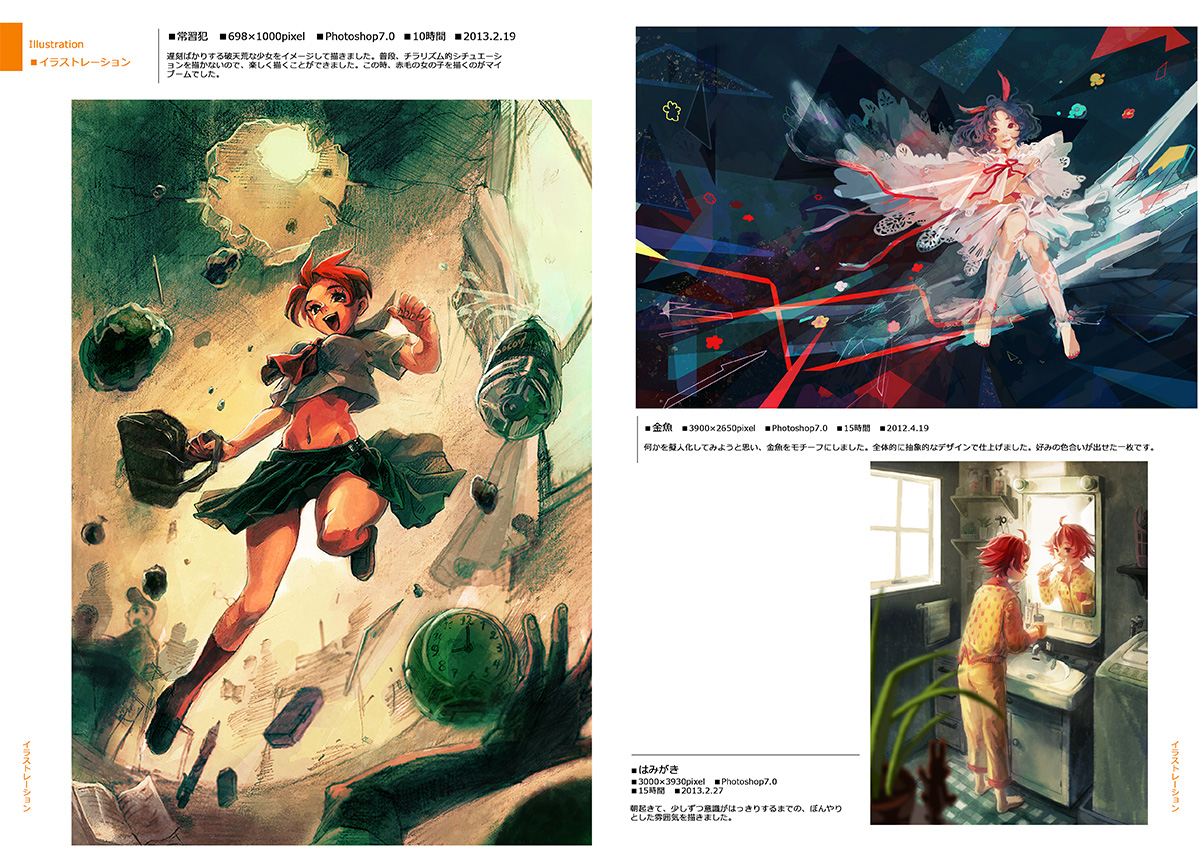
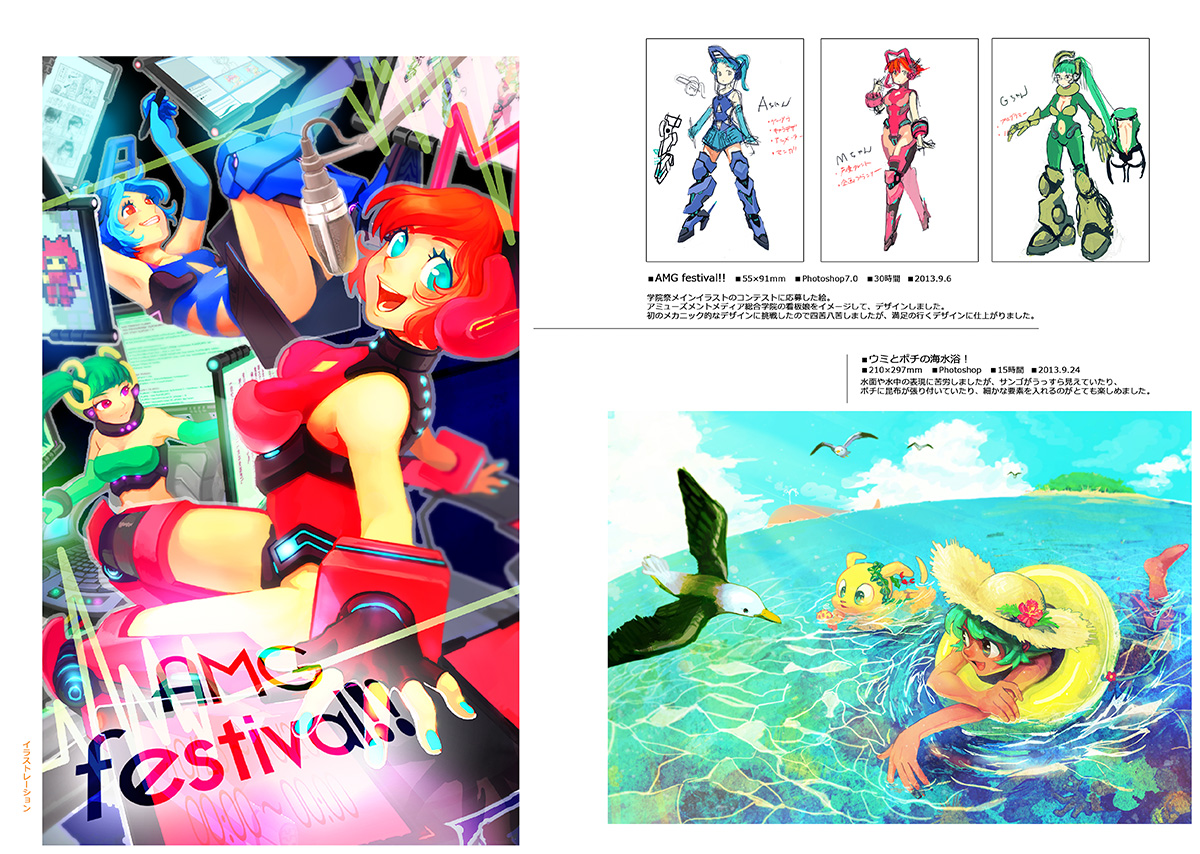
小林:キャラクターのデザインは、動きを生かしたものがイメージできていますね。今の「KINGDOM HEARTS」シリーズの仕事にそのまま繋がっています。
下河邉:次はゲームの企画系です。
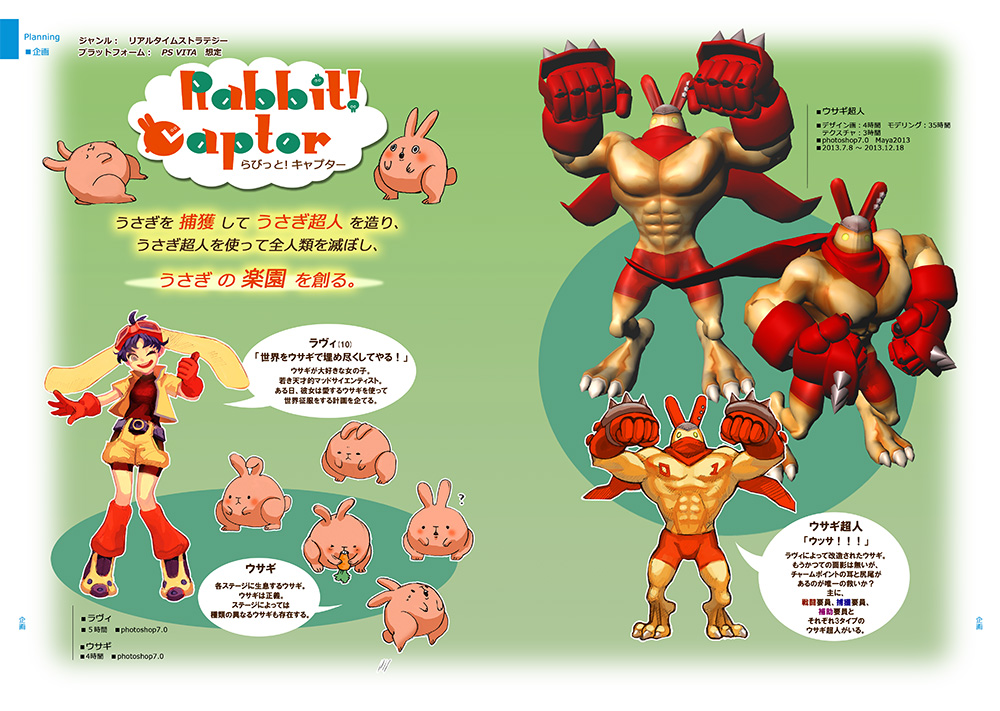
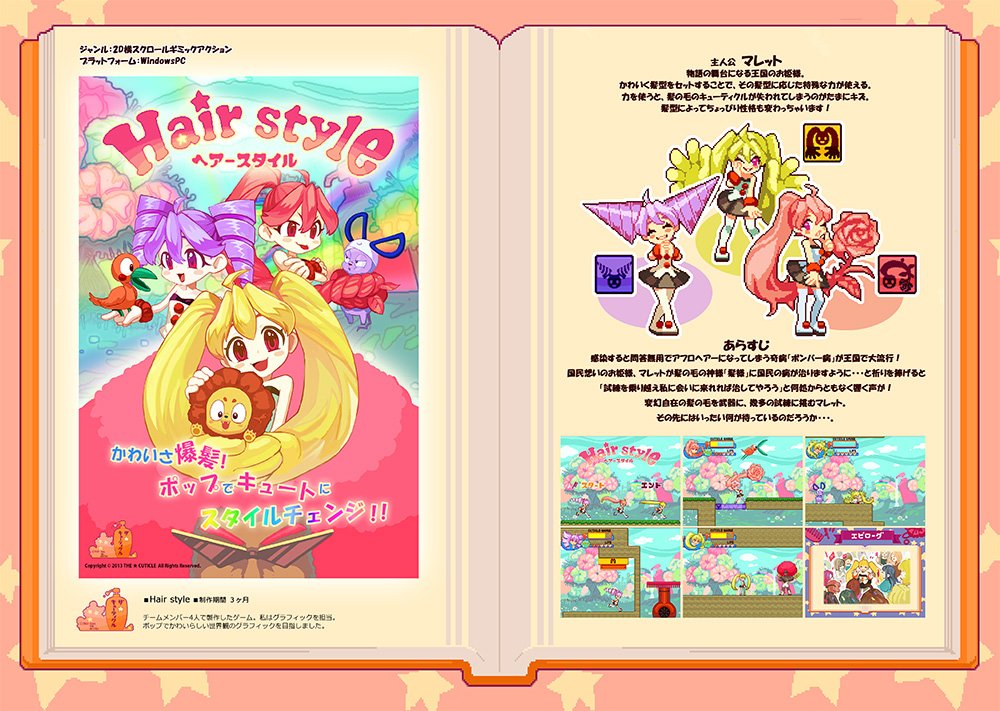
下河邉:作ったゲームのリソースやアニメーションを紹介しました。自分の今の技量でゲーム制作をする場合に、どういうものができるのかを提示しています。
最後に番外編として載せたのは、高校の卒業制作の展示会の様子です。
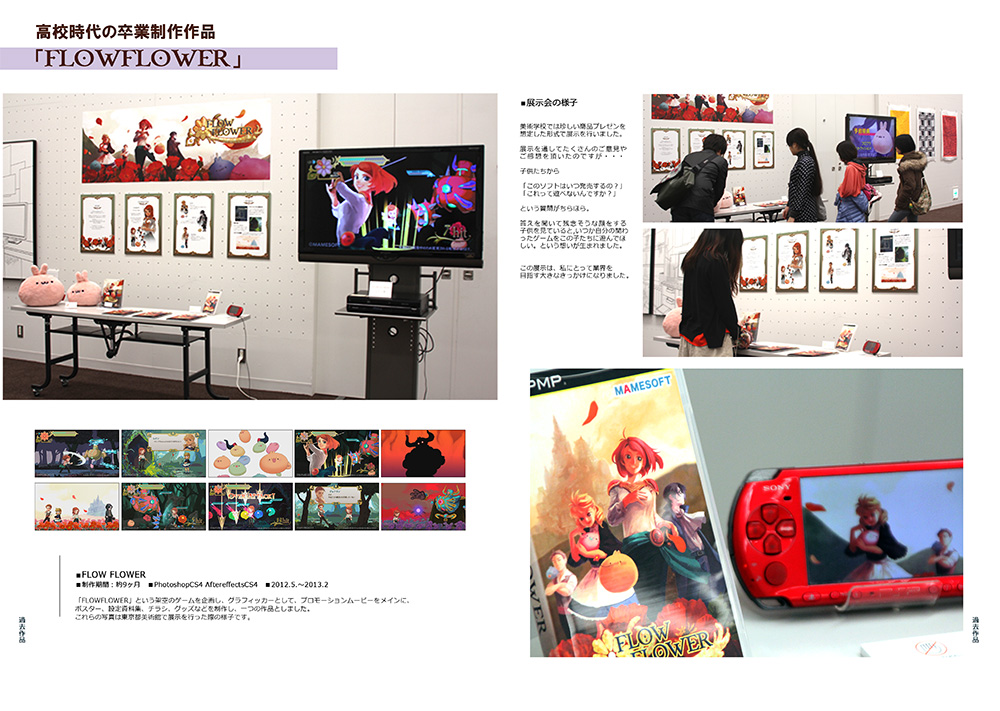
理想は「この人がゲームをつくったら」と想像できること
── 採用も経験された小林さんに、ポートフォリオについて解説をお願いします。
小林:3Dも2Dも載せていて、バランスがいいですね。デザインのコンセプトや意図もしっかり説明している点も素晴らしいです。
さらに、ポートフォリオの内容が全て、ゲームのデザインに紐づいたものになっていて、細部まで無駄がないですね。「この人がゲームを作ったらこういうものになるだろうな」と想像できます。学生さんは何を見せればいいかわからない人が多いので、学校でやった課題を全部詰め込んでしまう人もいるんです。抽象的で難しいものが入っていても、ゲーム会社としては評価するのが難しいですね。
── ゲーム会社に入りたければ、その思いが伝わるポートフォリオがいいんですね。
小林:そうですね。ポートフォリオを作っている本人がその意識を持っていないと、ゲームを作りたいという思いがアピールしきれません。 ゲームのキャラクターデザインをする上では、見る側の視点も意識する必要があります。そういう意識を持てば、内容についての考え方を変えられるんじゃないかなと思います。
僕がポートフォリオを見るときは、どういう考えでデザインしたかを重要視しています。もちろん作品のクオリティも大事ですが、綺麗な作品でも説明なしで載っていると、意図が伝わってこないんです。というのも、今はネットを検索するとたくさんのキャラクターの画像が出てくるので、それらを適当に混ぜて描く人もいるんです。だから、自分がどういう考えでそのキャラクターを作ったか、という説明も書いてほしいですね。
── 下河邉さんのポートフォリオには、描き下ろした作品も載せているんですか?
下河邉:ポートフォリオ用に用意したものもありますが、学校の課題で作ったものが多いですね。2年制の専門学校だったので、1年経ってすぐに就職活動が始まり、大慌てでまとめました。自分はゲームを作るという目標があったので、限られた時間の中で制作するものを余すことなくポートフォリオに入れられるよう、自分のやりたいことの目標を定めて課題に取り組むよう初めから意識はしていましたね。
同じ課題を与えられても、背景を描く人もいますし、プロジェクトを作る人もいます。それぞれアプローチが違うんです。私はキャラクターデザインをしたかったので、課題ではキャラクターデザインに関することに取り組むようにしていました。自分が将来作りたいものや世界観にどうやったら近づけるのか考えながら、自分のものにするために作品を作りました。
小林:ゲームのデザインと一口にいっても、キャラクターや背景、エフェクトなど色々あります。そのなかから自分が何に興味があるのかを見つけるのは、学生のうちからできる事だと思います。ポートフォリオを見るときは、「この人は背景の絵がほとんどだから、キャラクターデザインではないな」という見方をするので、ポートフォリオを作る時点でやりたいことを考え抜いて、しっかりアピールしてほしいですね。
ただ絵を描きたいというより「ゲームをつくりたい」
── イラストレーターには、フリーランスとして働くという形もあると思います。下河邉さんは、就職活動の時にフリーランスになるという選択肢は考えなかったのでしょうか?
小林:ゲームの仕事に携わっているフリーのイラストレーターの方もいますが、一般的には、ある程度名の売れた方がメインキャラクターデザインで参加するパターンが多いですね。そういう関わり方だと、ゲームの中身に深く関わることは少ないんです。弊社のアーティストを目指す人は、「絵を描きたい」というよりも、「ゲームを作りたい、その中で絵を描きたい」という方が多いです。
ゲーム会社がゲームを作るときは、 全スタッフを一つの会社の中でまかなうこともありますし、一部は外部の力をお借りすることもあります。それは会社ごとじゃなくて、作品のチームやプロジェクトの方針によって決まります。
── では「ゲームのデザイナー」になりたい場合、まずは会社に入った方がいいのでしょうか。
下河邉:実際に会社の先輩方にはすごくお世話になりました。デザインを見せた時に「何をやりたいかが伝わってこない」「ちゃんと考えて描かなきゃいけない」と、よく言われました。
小林:エネミーはデザインで攻撃方法や弱点、パワータイプなのかスピードタイプなのかを、プレイヤーがぱっと見たときに予測できるよう伝える必要がありますから。
下河邉:学生時代からキャラクターデザインは好きで、専門学校内の仕事も請け負っていましたが、自分が良いと思ったものを好き放題に描いていました。もちろんそれも大事ですが、入社してプロとしてデザインしていくうちに、受け取る側の気持ちを意識するようになりました。そういう思考を実践していく上で自分に足りなかったものがどんどん埋まり、キャラクターデザインというものに対する理解がより深まったんです。
学校で学んだいろんなツールや手法は、その世界を知るきっかけにしかすぎません。ツールを覚えたりするのは、自分で勉強しようと思ったら勉強できるものです。プロになるには、デザインしていく上でどのような物が求められているか、内容について周囲としっかり相談するかなど、デザインしていく上で必要な思考や分析力を養うことの方が重要だったな、と気づきました。
学生時代はまだ自分の客観視が甘く得意分野が定まっていませんでしたが、入社後に経験を積むことによって、キャラクターデザインのなかでも、ユニークでポップなファンタジーチックな路線が得意だと思えるようになりました。先輩方にフォローをしていただきながら見出してもらったところは大きいです。
小林:自分の得意なものを認識して強みを伸ばすのは、会社員として働く上でも大事なことです。
── 会社員はフリーランスと違って、自分の特徴よりも他に合わせる力の方が重要なのかと思っていました
小林:会社の規模によっても変わりますが、弊社の場合は大きなプロジェクトが多いので、キャラクターや背景などは分業で作っていきます。ゲーム会社の中でも珍しいのですが、新卒でも応募職種に自由度があり、本人の強みを活かせる領域をある程度決めた状態で入社してもらいます。なので、各分野においてプロフェッショナルな方が求められるケースが多いです。
背景もキャラクターも動きも総合的に作れる方が小規模なプロジェクトなどでは重宝される場合もありますが、すべてが平均的になりすぎると専門職を求めているところにはちょっと実力が足りないかもしれません。
── 小林さんは『スクールガールストライカーズ』を担当されているということで、かわいい女の子が得意分野なのでしょうか?
── 得意分野は、変わるものなんですね。
── 今は他にどのような作品に携わっているのでしょうか?
── 社内フリーみたいな働き方をしているんですね。
── 入社してからは、お仕事はどういうふうに決まるのでしょうか。
小林:社内でプロジェクトが走り出す際には、「デザイナーが足りないので、このプロジェクトをこういう絵柄でやってもらおう」と人を探すケースが多いですね。
── 最初のお仕事は、やっぱり大変でしたか?
── いろいろチャレンジできる環境なんですね。
プロのデザイナーを目指す人へ
── プロのイラストレーターを目指す若者に、アドバイスをお願いします。
── なかなか難しそうですね。
下河邉:アイデンティティは、何かを見て感動したときや、他者と考えを共有したときなどに形成されていきます。毎日の生活をなんとなく過ごすのではなく、自分が何を思ってそれに取り組んだのか、深く掘り下げてほしいです。そうすれば、理屈や感覚の引き出しをふやすことができますし、どんな対象にも興味を持てる力も養えます。
イラストレーターは、自分が作ったものが誰かの経験や思い出の一部となる、楽しくて素敵なお仕事です。経験していく上で無駄なものは何もありません。失敗を恐れず、作品作りに励んでください。
── 最後に、採用も経験された小林さんにお聞きします。ずばり、どんな人と働きたいですか?
── ありがとうございました!

